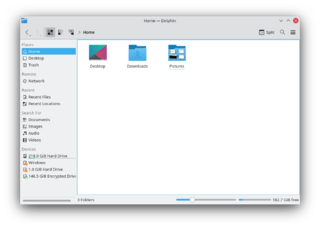Dolphin
 |
Kullanıma odaklanmış dosya yöneticisi |
Özellik Özeti
İlk bakışta sade bir dosya yöneticisi olarak görünür ancak çok yeteneklidir. Bazı yetenekleri:
- Pencere bölme - iki dizini aynı anda görüntüleyin ve kullanın
- Ayrı her pencere için bağımsız olarak ayarlanabilen (ve hatırlanılan) görünüm nitelikleri
- Sekmeli gezinti
- Sağda isteğe bağlı bilgi paneli
- Pencerede gösterilmesini istediğiniz önemli nitelik bilgilerini seçin
- Hızlı gezinti için breadcrumb (kırılabilir) gezinti çubuğunu kullanın
- Tek tuşla değiştirilebilir gezinti çubuğu
- Geleneksel gezinti için Klasör Ekleme paneli
- Şuan gezdiğiniz dizin içerisinde terminali açma
- Çoğu işlevler klavye kısayolları ile kontrol edilir
Öğreticiler
Philosophy
Dolphin is a file manager focusing on usability. When reading the term Usability people often assume that the focus is on newbies and only basic features are offered. This assumption is wrong.
Target User Group
Focusing on usability means that features are discoverable and efficient to use. The feature set is defined indirectly by the target user group of Dolphin:
- Lisa: Lisa is familiar with computers since 10 years. Due to her job she has experience with Word, Excel and Outlook. At home she mainly uses the computer for browsing the web and writing e-mails. She requires a file manager for managing photos from the camera, documents she gets per e-mail or PDF-documents she downloads with a browser. Lisa knows concepts like folders and a file hierarchy, but she is not familiar with the file hierarchy of Linux.
- Simon: Simon has been a developer at a software company for 8 years. At home he uses a file manager to maintain his large collection of photos and music. Additionally he owns a small homepage and needs to transfer updated files on the FTP server. Moving and copying files are regular tasks in Simon's workflow.
Not part of the target user group of Dolphin are Fred and Jeff:
- Fred: Fred is 75 years old and is able to write e-mails and browsing the web. He is not familiar with file hierarchies and stores all his documents on the desktop.
- Jeff: Jeff is Linux-freak since the age of 16 a few years ago. He is developer and in his spare time he acts as administrator for a small company. Jeff has two monitors to keep the overview about his huge number of opened applications.
This does not mean that Fred or Jeff cannot work with Dolphin. But there might be features and concepts of Dolphin that overburden Fred. Also Jeff might miss some features which are a must-have for his daily work.
Non-Intrusive Features
Before a feature is added in Dolphin, it is checked whether the feature is mandatory for the target user group. If this is not the case, then this does not mean that the feature cannot be added; first it must be clarified whether the feature might be non-intrusive, so that it adds value for users outside the primary target user group of Dolphin. Non-intrusive is mainly related to the user interface. A feature that adds a lot of clutter to the main menu, context menus or toolbar might harm the target user group. In this case the feature will not be added.
A good example of a feature that is non-intrusive is the embedded terminal in Dolphin. It only requires one entry inside a sub menu, but adds great value for Jeff, who is not part of the target user group.
Options
Options are mandatory as the user "average Joe" does not exist. Still it is not the goal of Dolphin offering options for all kind of things. Again the focus is on the possible needs of the target user group. Each additional option makes it harder finding other options, so the same rules for features are applied to options too.
Püf noktaları, İpuçları ve Sorun Giderme
Problem: Dolphin'in ve/veya menülerinde hiç bir seçenek yok. Sistem Ayarlarında Nepomuk etkindir.
- Çözüm: ~/.kde4/share/apps/dolphin klasörünü (bazı dağıtımlarda ~/.kde/share/apps/dolphin şeklinde olacaktır) adlandırın ve Dolphin'i yeniden başlatın. Bu Dolphin özelleştirmelerini yok edecektir fakat menü ögeleri geri gelmeli. Eğer her şey istediğiniz gibi çalışırsa bu klasörü silebilirsiniz. Bu, KDE 4.4'ten 4.5'e geçiş yaparken olmuştu.
Problem: Özel bir dosya türünü açmak için bir uygulama seçtiğimde, diğer dosya türlerini de etkiliyor gibi görünüyor. Sanki Dolphin "iki farklı dosya türü" arasındaki farkı anlayamıyor.
- Çözüm: Muhtemelen KDE platformu bu iki farklı dosya türünün farkını bilmiyor ve bu dosya türünü bilinen dosya türü ile ilişkilendiriyor. Bu, XML-tabanlı dosya türlerinde ortak bir durum ve hatta kendi dosya uzantılarını kullansalar bile (örn. .xliff veya .graphml), KDE platformu tarafından bilinen bir dosya türü değillerse diğer bir XML dosyası olarak değerlendirilecekler ve XML dosyasını açmada kullanılan varsayılan uygulama ile açılacaklar.
- Bu durumu çözmek üzere tanınmayan bir dosya türü için bir giriş oluşturmak için Dosya İlişkilendirmelerini kullanabilirsiniz.
Problem: Dolphin's Find File service doesn't find files you know are on your computer.
- Solution: Reindex Baloo. Baloo is a file indexing and search service that Dolphin uses to search for files. It needs to be indexed to work. To solve this problem, in a terminal type, balooctl check
Also see forums and the Dolphin Handbook.
Anahtar Kelimeler
Dosya yönetimi, dosya yönetici, dosya göz atıcı, etiketler, meta bilgisi, Nepomuk
